A Publication of
THE JOHN MEADE FALKNER SOCIETY
Founded 8th May 1999
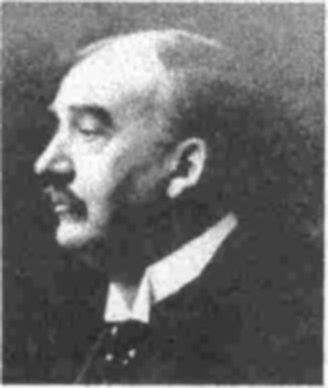
A Publication ofTHE JOHN MEADE FALKNER SOCIETYFounded 8th May 1999 |

| |||
| Newsletter No.14 | 03 January 2004 | |||
New Members
Since the last Newsletter in July, the Society has welcomed two more members.
Joan Moody
After her unbounded hospitality in entertaining us at Cobb House, Burford on our “JMF Away day”, Joan has now given the
Society a bonus - by joining! She met Raymond, already a member, in 1950, married in 1955 and “ever since then there isn’t much that we
haven’t done together”. They co-wrote Book of Burford published in 1983. Their efforts to learn everything they could about
the town led Joan early to the JMF connection, but she was actually reading his work long before. Joan still has in her possession the first
Penguin edition (1946) of Lost Stradivariusgiven to her by her father. It is good to hear that “it was when we entertained the
most delightful people here on the Society’s visit to Burford that I knew I could not possibly stay on the outside any longer!” Thank you, and
welcome, Joan.
Ian Jackson
has joined as a result of the good offices of Edward Wilson. He hails from Berkeley, California, and his letter heading proclaims him as
an Antiquarian and Scholarly Bookseller. A fine profession., which simply reminds me of Cicero’s dictum, “A room without books is as a body
without a soul”.
Two April 2002 celebrations of lives connected with that of John Meade Falkner
On consecutive Saturdays in late April 2002, just short of seventy years after Falkner’s death, impressive memorial services were held
in Suffolk and in Hampshire in celebration of the lives of two remarkable women who had close, though very different, links with him.
In St John’s Church, Bury St Edmund’s on 20 April, thanks were offered for the long life of Anthea Radice (1917-2000) in a service
which combined readings, hymns and addresses with a wide range of musical tributes which reflected her skill and devotion to the teaching of
music over a long period, a commitment which continued almost to the time of her death. Anthea was the daughter of Alfred Guillaume,
Professor of Hebrew and Oriental Languages in the University of Durham and Rector of the nearby church of St Mary le Bow. In the 1920s
Guillaume moved to Oxford, and during that period acted as joint editor with Charles Gore of A New Commentary on Holy Scripture,
published by SPCK in 1928. Falkner was a close friend of the Guillaume family, and seems to have had a particular affection for the young
Anthea, who decades later, could still remember with pleasure some of the gifts he had given her as well as his often eccentric behaviour. In
the early 1980s, at a time when her husband, Rev Radice was still actively involved in a Suffolk parish, Anthea was generous enough to make a
long railway trip to and from Oxford in order to talk about her recollections of Falkner’s visits to her childhood homes, both in Durham and in
Banbury Road, Oxford.
At noon on Saturday 27 April, in the quiet setting of the little church at Stratford-sub-Castle, (lying below the ruins of Old Sarum),
family and friends gathered for a service of thanks and praise for the life of Kathleen Falkner, who passed on in February 2002, aged 94. Born in
Dorchester, after working in a number of different fields, including art, Kathleen Vidler married Tom Falkner, the son of JMF’s younger brother,
Charles. From the end of the 1940s Kathleen and Tom lived in Rose Cottage in Stratford-sub-Castle, Tom working on behalf of the Cathedral in
Salisbury. He gathered together a considerable collection of JMF memorabilia, including cuttings, photographs and artefacts. Nicholas Aldridge
and Ken Warren both visited Tom in the early stages of research into JMF. After Tom’s death in 1983 Kathleen looked after his collection of
JMF materials with loving care. Even more important was the enthusiasm with which she supported the work of those interested in JMF’s life.
Above all however a visit to Kathleen Falkner, either at Rose Cottage, or from 1997 in her retirement residential home overlooking Swanage Bay
was an invariable source of blessing and uplift. She warmly supported the foundation of the John Meade Falkner Society, and after unveiling
the memorial plaque in his name at East Fleet Church on May 8th 2001, graciously entertained family and members of the Society at luncheon in
the appropriate setting of the Moonfleet Hotel. It was typical of her farsighted generosity that in her will she remembered the Society with a
generous endowment.
Ken Warren
The Poems
I am in the process, through Michael Daniell, of getting quotations for possible publication of a c.96 page softback. Watch this space.
Journal No. 5
I already have a delightful piece from Ken Warren on a holiday JMF took with friends, in the summer of 1898, into the wildest recesses
of Berkshire. I also want to publish two letters by JMF and a contemporary critique - all on the subject of The Nebuly Coat.
More offerings by members, or non- members, will be gratefully received - to reach me by the end of April, please.
A Letter from Tom Falkner
Nicholas Aldridge
Rose Cottage,
Stratford-sub-Castle,
Salisbury, Wilts
How quintessentially English the address is, English despite - or because of - its dallyings with Latin and Norman French! What
flower sums up the pink and white English complexion? What dwelling place houses the honest English yeoman? What town marks the spot
with that most significant of crossings - road and river - as well as giving us Shakespeare and Joan Littlewood? What is an Englishman’s home?
I will not labour the point. Advertising teams could have scratched their heads and combed their thesauri and never in a month, of Sundays or
of weekdays, come up with an address so perfectly English.
And the letter was ridiculously English, too; typed, but topped and tailed in an attractive compromise of copperplate and italic, it was
to thank me for my thank-you letter to him.
During our engagement in the beautiful summer of 1971, I had introduced my “soon-wife”, as the boys at Larchfield called her, to John
Meade Falkner, and they got along famously. I had feared that he might be a little dry and ponderous for her; but she was soon rivalling me in
filling notebooks with dates, facts and theories. I was intending to write a biography of JMF and in those blessed days leads seemed to sprout
wayside as my feet trod lightly down the path of amateur research.
The Falkners’ reply to my tentative suggestion that I might visit them and ask a few questions was generous in the extreme. I was to
come with my wife for an evening of supper, question-and-answer and general conviviality before going out to see the Salisbury “son et
lumière”. In the morning, after a restful night at Rose Cottage, we should be left on our own with TMF’s collection of Falkneriana, to read,
admire and copy as much as we liked. Laptops were not yet with us, but we did have a small tape-recorder. It was on this occasion that he gave
me the silhouette which appears in Kenneth Warren’s Durham pamphlet and excellent biography.
All went according to plan. The Falkners were perfect hosts and delightfully enthusiastic without being “know-all”. I wondered how
many times a year they took similar trouble to encourage Falkner fans. “Of course you’re not the first,” Tom had said with a deprecating laugh
when we met.
And so we come to the letter. On the way back from the Falkners the next day, we had visited Fleet and been rather disappointed by it.
Nearly all the letter is occupied with this topic, which may include some ideas that will interest students of Moonfleet.
Rose Cottage,
Stratford-sub-Castle,
Salisbury, Wilts
12th August 1972
![]()
How kind of you both to write, but the pleasure was mutual! We both greatly enjoyed
having you here and much hope there will be further opportunities.
I was interested in what you wrote about the Moonfleet Hotel. I feel very vague about it
but Kelly’s Directory of Dorsetshire (1939) refers to the Mohun tombs in the sanctuary of the
old church and also to the big house in the following terms: “Near the village is Fleet House,
the property and residence of Lady Noble: it is a handsome Georgian mansion, originally built
1600, with grounds of 136 acres, and commands views of the Isle of Portland and the English
Channel. Lady Noble is lady of the manor and principal landowner.”
I have always understood that Lady Noble bought the house because of its connections with
Moonfleet and her admiration of JMF. I do not think the Noble family ever had property
in Dorset, their links being with Scotland. At some point in time - I would think in the 1940s
- the name was changed from Fleet to Moonfleet, though whether that was by Lady Noble or by the
purchasers of the house for an hotel, I do not know. Kelly’s statement that the house commands
good views of the English Channel is interesting in view of “Maskew’s Match” which Grace kept
lit in one of the windows of “Moonfleet Manor”. I wonder if the farm house also has views of
the Channel from its windows.
I should be interested to know if the vicar has any comments to make.
With best wishes,
Sincerely yours,
![]()
“How to generate more bookings for your courses”
After our successful Burford meet, I read a handout, which arrived unsolicited through
the post a few days later. If I attended this company’s day course - “only £295 + VAT” [but,
to be fair, it included lunch & seminar notes] - I would learn “how to source the best mailing
lists”; “four fundamental marketing concepts and how to apply them”; “clever tried and tested
marketing tips”; “the 14 items that must be mentioned in your advertising material”; and “how
to win more referrals”.
Unfortunately, I have other, more pressing, uses for £295. Thus, apologies if future JMF
course advertising is not up to scratch.
Burford - Saturday 20 September, 2003
Giselle Panero, who travelled all the way from Argentina to join us on our “Burford Day”,
sent this account of her trip.
My JMF trip to England
Ever since I read ‘Moonfleet’, I’ve been interested in visiting those places connected to
it. And this interest, in addition to the meeting, which would take place in Burford, persuaded
me to make a trip to that faraway Land.
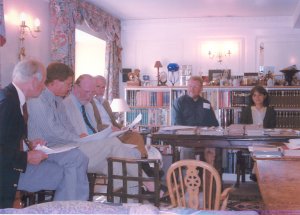
Ken Warren, Chris Hawtree, Nicholas Aldridge Alan Bell, Andrew Nye and Giselle at Ray and Joan Moody’s home |
Blessed with sunny days, I visited Durham and its splendid Cathedral with its huge cylindrical pillars. And thanks to the pleasant librarian, I was fortunate enough to be led into Falkner’s house. Next I visited Lulworth and its stunning white cliffs, which remind me of the smugglers in ‘Moonfleet’ and make one wonder how hard a job it must have been, in those days, to carry those heavy kegs up the cliff to a safe place. In Carisbrooke Castle I visited the Wellhouse where a donkey standing on the treadwheel demonstrated how water used to be drawn from the deep well. I remember the guide spilt some water into the well and only after ten seconds could we hear it reach the bottom! Inside the Castle I found, to my surprise, a cross engraved on a Stone Capital, which showed “the family badge of Elizabeth, daughter of Lord de Mohun and second wife of William de Montacute, Earl of Salisbury, Lord of the island from 1385 to 1397”. It was interesting to come across more evidence of this once powerful family. |
The Old Fleet Church is always a must for me to visit. Though it is only a chancel lacking great pillars, an organ or stained glass, there is something special in it that makes me eager to visit it over and over again. I only hope that it will always be done up and preserved. The Dike of pebbles or ‘bank of pebbles’ as the kind bus driver called it, is really amazing. I never imagined it to be so wide and to go up and then down into the sea so abruptly. I could have stayed there for hours listening to the waves washing away the pebbles, the sound is unique! Not far from the Dike of pebbles is the Church of All Saints, in Wyke Regis, where I was eager to find that tombstone which resembles that of ‘David Block’s’, very well described by Falkner. It was five o’clock when I got there and the |
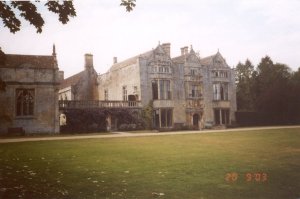
Burford Priory, which we visited after lunch |
church had already been closed, but fortunately, after wandering about the churchyard, I
eventually found William Lewis’s tombstone and saw the engraving of the two ships very well
depicted in ‘Moonfleet’. Unfortunately what was written below has been eroded, but did Falkner
immortalize those words when he wrote the inscription of David Block’s tombstone?
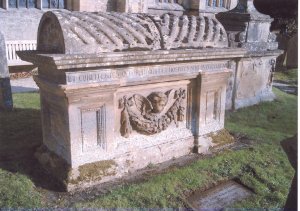
John Meade Falkner’s last resting place |
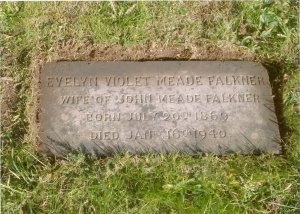
We “re-discovered” Evelyn Falkner’s grave slab |
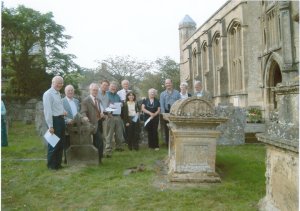
Michael Daniell, Peter Harris, Edward Wilson, Christopher Hawtree, Andrew Nye, Ken Warren, Giselle Panero, Joan Moody, Kenneth Hillier, Penelope Leaf. |
Finally, my last destination was the beautiful town of Burford. There, together with the other members, we were warmly welcomed into Raymond and Joan's house, where we all had the chance to appreciate Kenneth's amazing collection of books, letters and pictures related to JMF. Later that day we were invited to the church where JMF is buried and we had the opportunity to admire the beautiful stained glass once donated by him. It was worth being present that day and I will never forget it. Finally I would like to thank all the members present that day for their hospitality and for that little blue book which has eventually given me the chance of reading JMF's two other great novels. |
DELECTANT LIBRI PROSPERITATE ARRIDENTE“These rather dull passages...have been freely and somewhat generously paraphrased” (Wall):
CONSOLANTUR NUBILA FORTUNA TERRENTE
ECCE PER LIBROS ADJUTI BEATITUDINIS NOSTRAE
MERCEDEM ATTINGIMUS, DUM EXISTIMUS VIATORES
If Fortune smiles Books bring delight,So who is responsible for this “considerably more accomplished” translation? None other than John Meade Falkner, Honorary Librarian to the Dean and Chapter of Durham Cathedral!
And if She frowns they mock her spite,
And Books shall guide a travelling Soul,
When daylight dies to reach its goal.
RETURN TO
JOHN MEADE FALKNER PAGE